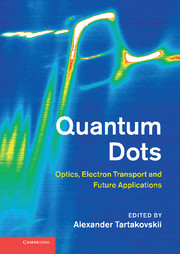Book contents
- Frontmatter
- Contents
- List of contributors
- Preface
- Part I Nanostructure design and structural properties of epitaxially grown quantum dots and nanowires
- 1 Growth of III–V semiconductor quantum dots
- 2 Single semiconductor quantum dots in nanowires: growth, optics, and devices
- 3 Atomic-scale analysis of self-assembled quantum dots by cross-sectional scanning, tunneling microscopy, and atom probe tomography
- Part II Manipulation of individual quantum states in quantum dots using optical techniques
- Part III Optical properties of quantum dots in photonic cavities and plasmon-coupled dots
- Part IV Quantum dot nano-laboratory: magnetic ions and nuclear spins in a dot
- Part V Electron transport in quantum dots fabricated by lithographic techniques from III–V semiconductors and graphene
- Part VI Single dots for future telecommunications applications
- Index
- References
2 - Single semiconductor quantum dots in nanowires: growth, optics, and devices
from Part I - Nanostructure design and structural properties of epitaxially grown quantum dots and nanowires
Published online by Cambridge University Press: 05 August 2012
- Frontmatter
- Contents
- List of contributors
- Preface
- Part I Nanostructure design and structural properties of epitaxially grown quantum dots and nanowires
- 1 Growth of III–V semiconductor quantum dots
- 2 Single semiconductor quantum dots in nanowires: growth, optics, and devices
- 3 Atomic-scale analysis of self-assembled quantum dots by cross-sectional scanning, tunneling microscopy, and atom probe tomography
- Part II Manipulation of individual quantum states in quantum dots using optical techniques
- Part III Optical properties of quantum dots in photonic cavities and plasmon-coupled dots
- Part IV Quantum dot nano-laboratory: magnetic ions and nuclear spins in a dot
- Part V Electron transport in quantum dots fabricated by lithographic techniques from III–V semiconductors and graphene
- Part VI Single dots for future telecommunications applications
- Index
- References
Summary
Introduction
Quantum dots have proven to be exciting systems to study light-matter interaction [32, 9]. Self-assembled quantum dots obtained by the Stranski–Krastanow growth mode have been the main system to date [32, 9]. Here we introduce a new type of quantum dot embedded in a one-dimensional nanowire. Quantum dots in nanowires offer a range of advantages over strain-driven Stranski–Krastanov quantum dots. In the case of quantum dots in nanowires, the light extraction efficiency can be very high for the quantum dot emission due to a waveguide effect in the nanowire [14, 45], theoretically approaching 100% according to simulations [14]. Since strain is not the driving mechanism during growth, unprecedented material freedom is available to the quantum engineer in the choice of materials for the quantum dot and the barrier material. At the scale of nanowires, both zincblende and wurtzite crystal structures can coexist, opening the door to a new type of confinement based not only on the material composition, but also on the phase of the crystal lattice [1]. The ability to electrically contact a single nanowire implies that all the current injected in a nanowire will flow through a single quantum dot, enabling an efficient interface between single electrons and single photons [33, 44]. In addition, electrostatic gating is highly versatile, allowing for coherent spin manipulation [36], charge state control [54], and the ability to control the exciton–biexciton splitting by an in-plane electric field [43].
- Type
- Chapter
- Information
- Quantum DotsOptics, Electron Transport and Future Applications, pp. 21 - 40Publisher: Cambridge University PressPrint publication year: 2012
References
- 1
- Cited by



